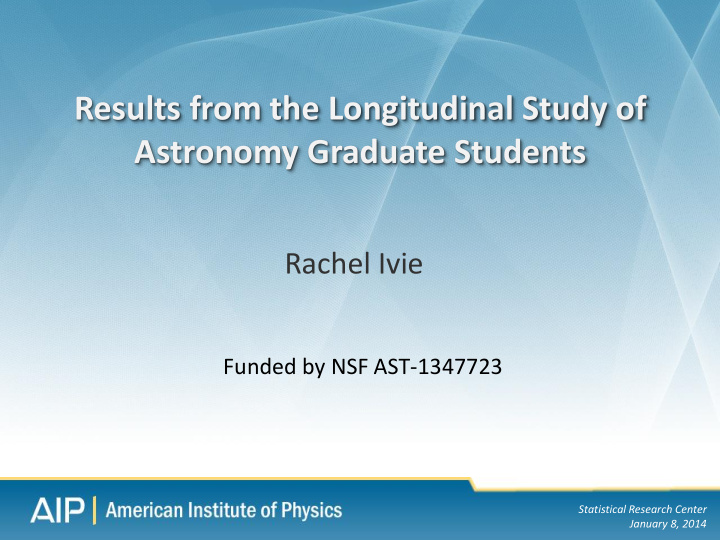



Results from the Longitudinal Study of Astronomy Graduate Students Rachel Ivie Funded by NSF AST-1347723 Statistical Research Center January 8, 2014
Background • All respondents were graduate students in astronomy or astrophysics during the 2006-2007 academic year. • First survey data collected 2007-2008. • Second survey data collected 2012-13. Statistical Research Center January 8, 2014
3 Outcomes of Those Without PhDs Left without grad degree 9% PhDS Not PhD 83% 17% Astro or Physics Students 7% Other Students 1% Statistical Research Center January 8, 2014
Outcomes of Those With PhDs Never Postdoc 23% Completed Postdoc 15% Not PhDs PhDs 17% 83% Current Postdoc 40% Postdoc no details 5% Statistical Research Center January 8, 2014
Comparing Those Who Did Not Take Postdocs to Those Who Completed Postdocs • Completed postdocs: Median degree year is 2008. Most (73%) had one postdoc. • Took no postdoc: Median degree year is 2010. Statistical Research Center January 8, 2014
Employment Sectors Never Postdoc Completed Postdoc University 47% 61% Federal agency (not lab) 4% 10% Observatory 3% 9% National lab 4% 8% For profit 19% 6% Non-profit 4% 2% UARI 4% 1% Government contractor 5% 1% Two-year College 5% 0% Other 4% 3% 100% 100% Statistical Research Center January 8, 2014
Field of Employment Never Postdoc Completed Postdoc Astronomy 38% 70% Physics 18% 11% Medical or Health 8% 5% Hardware 7% 4% Engineering 2% 4% Earth Science or Geology 8% 4% Business and Finance 9% 2% Education, formal and informal 2% 2% Software 7% 0% Other 2% 0% 100% 100% Statistical Research Center January 8, 2014
8 Current Postdocs • Median degree year is 2010. • Most (61%) are in first postdoc. • 35% are in second postdoc. Statistical Research Center January 8, 2014
Postdoc funding sources for current and completed postdocs 100% 90% 80% 66% 70% 60% 50% 38% 40% 25% 30% 20% 10% 0% Based on own proposal Funded on someone Funded by research else's grant center, lab, or observatory Percentages add to more than 100% because respondents could have more than one answer. Statistical Research Center January 8, 2014
10 Different job experiences • Never took a postdoc • Completed a postdoc • Currently a postdoc Statistical Research Center January 8, 2014
Percentage who do research in primary position 100 90 80 70 60 50 40 30 20 10 0 Never postdoc Completed postdoc Current postdoc Statistical Research Center January 8, 2014
What determines research agenda? Current postdoc All or mostly others' needs Complete postdoc both All or mostly my own expertise and curiosity Never postdoc 0% 20% 40% 60% 80% 100% Statistical Research Center January 8, 2014
Time available for research Current Postdoc Less than half Completed Postdoc About half More than half Never Postdoc 0% 20% 40% 60% 80% 100% Statistical Research Center January 8, 2014
How intellectually challenging is current job? 100% 90% 80% 70% Not at all challenging 60% 50% Challenging or somewhat 40% challenging 30% Extremely challenging 20% 10% 0% Never Postdoc Completed Current Postdoc Postdoc Statistical Research Center January 8, 2014
Astronomy graduate degree is appropriate background for primary position 100% 90% 80% 70% 60% 50% 40% 30% 20% 10% 0% Never Postdoc Completed Postdoc Current Postdoc Statistical Research Center January 8, 2014
16 Working Outside Astronomy 100% 90% 80% 70% 60% 50% Astronomy or 40% Physics 30% Not Astronomy 20% or Physics 10% 0% Never Postdoc Completed No PhD Postdoc Statistical Research Center January 8, 2014
17 Next Steps: Factors Contributing to Leaving Astronomy • Examine attrition rates for women and men • Look for effects of Mentoring The imposter syndrome Access to career opportunities and resources Funding, such as “soft money” Factors such as intellectually challenging work Discrimination “ Two-body ” problem Statistical Research Center January 8, 2014
18 Thanks to my colleagues Susan White and Raymond Y. Chu For more information Rachel Ivie Associate Director Statistical Research Center 301-209-3081 rivie@aip.org Statistical Research Center January 8, 2014
Recommend
More recommend